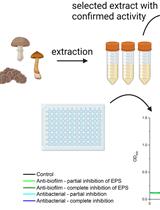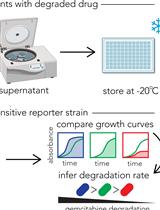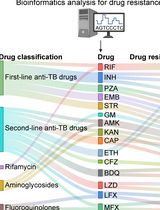- EN - English
- CN - 中文
Antimicrobial Sensitivity Assay for Bdellovibrio bacteriovorus
噬菌蛭弧菌的药敏试验
发布: 2020年12月20日第10卷第24期 DOI: 10.21769/BioProtoc.3865 浏览次数: 4905
评审: Alessandro DidonnaAmberley D. StephensAnonymous reviewer(s)
Abstract
Bdellovibrio bacteriovorus, an obligate predatory bacterium [i.e., bacteria that kill and feed on other bacteria (prey)], has the potential to be used as a probiotic for the disinfection of surfaces or for the treatment of bacterial infections. One option is to use this organism in combination with antimicrobials to potentiate the effectiveness of treatments. In order to make this approach feasible more has to be known about the ability of B. bacteriovorus to resist antibiotics itself. Standard assays to determine the minimum inhibitory concentration (MIC) are not suitable for B. bacteriovorus, since the small size of this bacterium (0.25-0.35 by 0.5-2 μm) prevents scattering at OD600. Since these predatory bacteria require larger prey bacteria for growth (e.g., E. coli dimensions are 1 by 1-2 μm), the basis for the antimicrobial sensitivity assay described here is the reduction of the OD600 caused by prey lysis during growth. Previous studies on predatory bacteria resistance to antimicrobials employed methods that did not allow a direct comparison of antimicrobial resistance levels to those of other bacterial species. Here, we describe a procedure to determine B. bacteriovorus sensitivity to antimicrobials which can be compared to a reference organism tested as close as possible to the same experimental conditions. Briefly, minimal inhibitory concentration (MIC) values of B. bacteriovorus are determined by measuring the reduction in absorbance at 600 nm of mixed predator/prey cultures in presence and absence of different antimicrobial concentrations. Of note, this method can be modified to obtain antimicrobial MIC values of other predatory bacteria, using different conditions, prey bacteria and/or antimicrobials.
Background
Bdellovibrio bacteriovorus is a Gram-negative predatory bacterium that "predates" upon other Gram-negative bacteria species, growing at their expense and eventually killing them. B. bacteriovorus as well as other predatory bacteria have the potential to be used as probiotics for disinfection of surfaces or for the treatment of bacterial infections (Tyson and Elizabeth Sockett, 2017; Madhusoodanan et al., 2019). The combined use of B. bacteriovorus with antimicrobials may enhance the effectiveness of these treatments. This necessarily entails B. bacteriovorus to resist the action of antimicrobials at their working concentration. Little is known on the antimicrobial susceptibility of B. bacteriovorus. However, the sequenced genomic DNA encodes membrane drug transporters (efflux pumps) and other antimicrobial resistance proteins (Rendulic et al., 2004). The sensitivity of B. bacteriovorus to antimicrobials cannot be assessed by a standard broth dilution assay, as it requires the presence of prey bacteria to grow.
In a 2014 study, Pasternak et al. made a first attempt to determine the antimicrobial sensitivity of predatory bacteria (Micavibrio aeruginosavorus EPB and Bdellovibrio exovorus JSS) by developing a modified antimicrobial disc diffusion method. However, this method provides a relative measure of antimicrobial resistance levels for the species analyzed, but does not allow to compare these values with those of non-predatory bacteria species as it does not use the same conditions of standardized assays (predatory bacteria require the presence of prey bacteria to grow).
In a study by Im et al. (2017), B. bacteriovorus was used in combination with violacein (an antimicrobial active against Gram-positive bacteria) to treat mixed populations of multi-drug resistant (MDR) pathogens. The aim of the study was to demonstrate that this combined treatment was more effective than treatments with individual agents (B. bacteriovorus or violacein). The efficacy of the treatments was evaluated in terms of reduction in the titer of MDR bacterial cells and, therefore, did not provide an indication of the degree of general antimicrobial resistance in B. bacteriovorus.
The method presented in this study allows to determine the MIC values of antimicrobials for B. bacteriovorus. Standard broth dilution assays (performed on non-predatory bacteria) are performed in liquid broth containing antimicrobial dilution series (typically two-fold dilutions) and are inoculated with a defined number of bacterial cells (5 x 105 colony-forming units (CFU)/ml). In order to test antimicrobials on B. bacteriovorus, the initial numbers of both B. bacteriovorus and prey bacterial cells have to be considered (initial predator to prey ratio, PPR). The numbers of B. bacteriovorus cells can be estimated reliably only after conducting the test (by plating in double layer agar plates), as their viability is strongly affected by culture conditions. Higher initial PPRs (comparable to a higher inoculum in standard broth dilution assays) can lead to an increased estimate of the antimicrobial minimal inhibitory concentration (MIC; i.e., the lowest concentration (in mg/L) of the antimicrobial agent that prevents visible growth of a microorganism under defined conditions) (Wiegand et al., 2007). The presented method requires the determination of different MIC values of a single antimicrobial at different initial PPR values. For this, serial two-fold dilutions of B. bacteriovorus cells and a fixed number of prey bacteria are added to a master plate with serial two-fold antimicrobial dilutions. In order to quantify the degree of resistance to a specific antimicrobial, the MICs determined at different initial PPRs must be reduced to a single value. This MIC value is obtained by curve fitting the MIC values at each PPR for each antimicrobial and definition of the MIC at the arbitrary initial PPR of 0.02 (which constitutes a low ratio that allows B. bacteriovorus to grow well and lyse almost all prey cells within 24 h under the experimental conditions). In order to compare the MIC values of B. bacteriovorus with that of other bacterial species, such as the prey bacteria, it is necessary to determine the MIC values under conditions resembling experimental conditions employed for B. bacteriovorus. In this way, the ratio between predatory and prey bacteria MIC values provides a comparative measure of the sensitivity to the antimicrobials tested on both species.
This method may not allow the determination of absolute B. bacteriovorus MIC values for bactericidal antimicrobials at concentrations equal or higher than the minimal bactericidal concentration (MBC) for the prey bacteria (Marine et al., 2020). This is because B. bacteriovorus may not be able to grow on inactivated prey bacteria at concentrations equal or above their MBC, since this would result in a lower estimate of the MIC (this is true especially for lysed prey bacteria or those with a compromised structural integrity) (Marine et al., 2020). To overcome this limitation, prey bacteria may be transformed with resistance genes for the specific antimicrobial tested and used in the B. bacteriovorus MIC assay. However, these resistance genes should not encode for a resistance mechanism that inactivates the antimicrobial. One possibility might be the use of resistance genes encoding multidrug resistance pumps (e.g., AcrAB-TolC, MacAB-TolC, MdfA, etc.) that efflux antimicrobials out of the cell.
The protocol presented below may be adapted to test other predatory bacteria, or use different experimental conditions (i.e., culture broth, temperature, aeration, prey bacteria species), or can be used on different antimicrobials. The only limitation to our knowledge is the use of predatory bacteria that grow well within 24 h.
Materials and Reagents
Breathable sealing membrane (Breathe-EasyTM sealing membrane, Diversified Biotech, catalog number: Z380059 )
Centrifuge tubes, 15 ml (Sarstedt, catalog number: 62.554.502 )
Centrifuge tubes, 50 ml (Sarstedt, catalog number: 62.547.254 )
Clear 96-well plates (BRAND, catalog number: 781662 )
Deep 96-well plates, 2.2 ml wells (BRAND, catalog number: 701354 )
Microcentrifuge tubes, 1.5 ml (VWR, catalog number: 20170-038 )
Parafilm M (Bemis, catalog number: HS234526A )
Petri dishes (Sarstedt, catalog number: 82.1472.001 )
Bdellovibrio bacteriovorus HD100 (source: Sockett RE, Queen's Medical Centre Nottingham)
Escherichia coli BW25113 (source: laboratory collection)
Agar (AppliChem, catalog number: A0949 )
Anhydrous sodium acetate (Roth, catalog number: 6773 )
CaCl2·2H2O (Emsure, Merk, catalog number: 102382 )
HEPES free acid (Roth, catalog number: 9105 )
MgSO4·7H2O (Roth, catalog number: P027 )
Peptone (BD, BactoTM, catalog number: 211830 )
Tryptone (BD, BactoTM, catalog number: 211699 )
Yeast extract (BD, BactoTM, catalog number: 212720 )
NaCl (Applichem, catalog number: A4661.5000 )
CaCl2 stock solution (see Recipes)
MgSO4 stock solution (see Recipes)
YT broth (see Recipes)
YPSC broth (see Recipes)
Ca/Mg/HEPES buffer (see Recipes)
Bottom agar (see Recipes)
Top agar (see Recipes)
LB agar (see Recipes)
Equipment
Benchtop centrifuge (from any qualified supplier)
Bottles, 250 ml (VWR, catalog number: 215-1593 )
Bottles, 500 ml (VWR, catalog number: 215-1595 )
Bunsen burner (from any qualified supplier)
Cuvettes (Sarstedt, catalog number: 67.742 )
Flasks, 250 ml (VWR, catalog number: 214-0423 )
Freezer, -80 °C (from any qualified supplier)
Plate incubators (from any qualified supplier)
Laminar flow hood (from any qualified supplier)
Inoculation loop (from any qualified supplier)
Microcentrifuge (Thermo Fisher Scientific, catalog number: 75002471 )
Multichannel pipette (8x) 100-1,200 μl (Gilson, catalog number: FA10039 )
Multichannel pipette (8x) 30-300 μl (Sartorius, catalog number: LH-729140 )
Phase contrast microscope, magnification equal or above 1,000x (from any qualified supplier)
Pipette 0.5-10 μl (Eppendorf, catalog number: 3120000020)
Pipette 10-100 μl (Eppendorf, catalog number: 3120000046)
Pipette 100-1,000 μl (Eppendorf, catalog number: 3120000062)
Plate reader (TECAN, model: Infinite M200 PRO)
Plaque visualization chamber ( Marine et al., 2020 : Figure S9)
Refrigerator, 4 °C (from any qualified supplier)
Shakers (Infors HT, Multitron Standard)
Spectrophotometer (Eppendorf, Biospectrometer basic, catalog number: 6135000017)
Water bath (from any qualified supplier)
Microwave (from any qualified supplier)
Software
Prism 5 (GraphPad, https://www.graphpad.com/scientific-software/prism/)
However, any other statistics software can be used by setting the modified Gompertz equation (Lambert and Pearson, 2000).
WPS Office (Kingsoft, https://www.wps.com/)
Procedure
文章信息
版权信息
© 2020 The Authors; exclusive licensee Bio-protocol LLC.
如何引用
Marine, E. and Pos, K. M. (2020). Antimicrobial Sensitivity Assay for Bdellovibrio bacteriovorus. Bio-protocol 10(24): e3865. DOI: 10.21769/BioProtoc.3865.
分类
微生物学 > 抗微生物试验 > 抗细菌试验
您对这篇实验方法有问题吗?
在此处发布您的问题,我们将邀请本文作者来回答。同时,我们会将您的问题发布到Bio-protocol Exchange,以便寻求社区成员的帮助。
Share
Bluesky
X
Copy link













